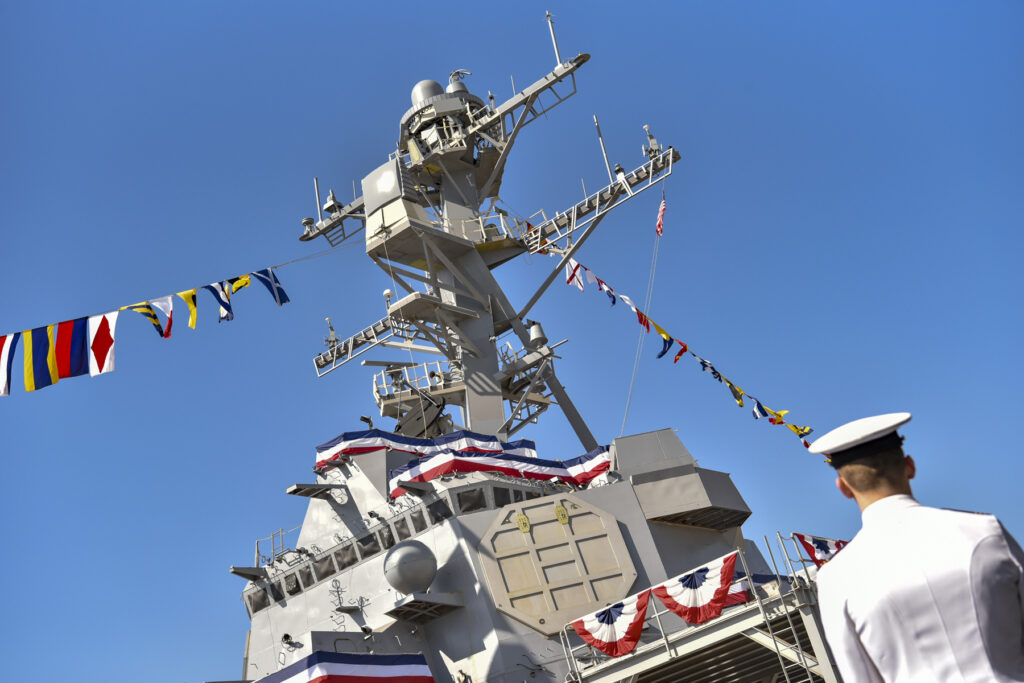
NATIONAL HARBOR, Md. — Lockheed Martin (Booth 1001) is promoting a new advancement to the Aegis Combat System that aims to increase the speed at which new upgrades can be made to the system.
Lockheed hopes to use this new architecture, known as Baseline 10, to shave months off the typical time frame to deliver a new capability to the fleet. The company says it is automating more tests to rapidly confirm software updates, calling Baseline 10 the “most comprehensive evolution of an Aegis baseline to date.”
Joe DePietro, Lockheed’s vice president and general manager of naval combat and missile defense systems, told Seapower in a phone interview that the Aegis Common Source Library makes all of this possible.
“It’s really enabled us to learn how we can transition to an integrated combat system and to deliver our system more quickly with capability to the fleet,” DePietro said.
Baseline 10 is new architecture that allows the team to push new capabilities into the library in three to four weeks instead of in three to four months in some cases.
“That allows us to always work from our most current capability,” DePietro said.
Baseline 10 will operate in much the same way as Baseline 9 did on Aegis Combat System-capable ships — such as cruisers, destroyers and littoral combat ships — it’s just that the latest version will feature a SPY-6 radar instead of a SPY-1. Under this new baseline, the team will continue to create capabilities through integration, push them into the library more quickly and, therefore, field new capabilities faster.
And it’s not just about fielding new technology, DePietro said.
“We’re also taking all of that tech that is fielded and getting them to work together,” he said, adding that these new developments will benefit not just the Aegis Combat System but related systems like Aegis Ashore.
It’s the speed at which all of this is happening that is particularly valuable, DiPietro said.
“If we keep the development pipeline going, we’re also pulling it all more quickly into the CSL [Common Source Library],” he said. “There’s development going on, and because of how we’ve set up the architecture and the pipeline, we can pull what was developed for Baseline 10 into Baseline 9. We are able to really leverage what’s going on, and you can also deploy it very quickly.”
Looking back at technologies in Baseline 7, it would take a couple of years to develop and field a new capability. Baseline 10 would rapidly accelerate that, he said.
“Recently, there was a critical need identified in operations, and we were able to take that feedback and get something back in basically less than two months,” he said. “I can do a medium-sized capability upgrade in anywhere from three to six months. And a full capability upgrade, like a new sensor or the programming of a missile, I can do that in less than a year.”
It’s not the coding or development that’s the challenge, it is having the architecture in place that allows that capability to be tested, validated and integrated more quickly, he said.
“You’ve got to get all of those pieces lined up,” DePietro said. “If you don’t have that architecture and the environment isn’t there, you’re behind the curve.”
The Arleigh Burke-class destroyer USS Jack H. Lucas (DDG-125), currently inching closer to commissioning, will be the first Baseline 10 ship, which marks a big milestone for the team and the architecture in general. The team has placed a node in Pascagoula, Mississippi, where the ship is built that can send data back to Lockheed’s labs, and then the labs can send data straight to the ship as integration efforts continue. That’s a lot easier than the old way of building physical hard drives and carrying them to the shipyard to load them up, DePietro said.
“It’s all about going faster,” he said.
- NAVSEA Office Seeks to More Rapidly Modernize Ship Technology Through Common Hardware: Official - April 7, 2022
- Official: Dahlgren Recently Tested ‘Hypercone’ Hypersonic Test Projectile - April 6, 2022
- Leidos PM: Big Vendors Must Do More to Open Electronic Warfare Interfaces to Developers - April 6, 2022






